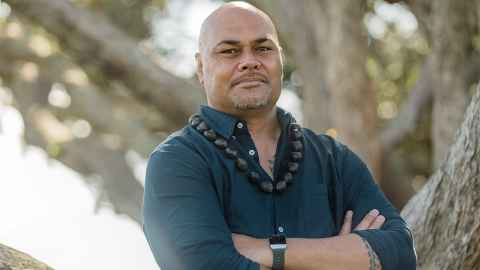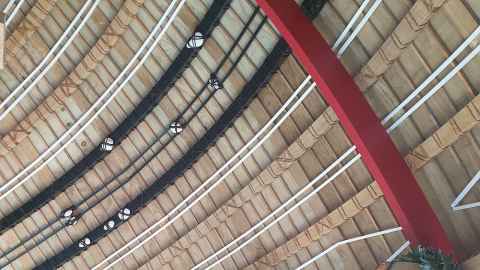Sāmoan language is more than just a means of communication, says Lama Tone. It's a key part of a new fale he designed for Glen Eden Primary School

A leai se gagana, e leai se aganu'u. A leai se aganu'u, ua pō le nu'u.
If there is no language, there is no culture. If there is no culture, the village is in darkness
From Māngere, South Auckland, and villages of Ūpolu and Savai'i in Sāmoa, Pesetā Fa'amatuainu To'oto'ole'aava Lama Tone weaves together gagana Sāmoa and Pacific architecture.
Tone spent much of his childhood growing up in Sāmoa and is a lecturer at the School of Architecture and Planning. His niche lies in transforming Pacific architectural concepts (old and new) into contemporary structure and spaces.
"The language is more than just a means of communication. It encompasses Sāmoan identity, culture and ways of understanding life. I believe our architecture starts with our words via proverbs, chants, and storytelling," Tone says.
"We are oral cultures."
The language is deeply rooted in customs, traditions, and Sāmoan knowledge, which is reflected in Tone's research, and the Glen Eden Primary fale he built and designed which opened last month.

A malu i fale, e malu i fafo
Sāmoan proverb
Tone used ancient Sāmoan proverbs like, A malu i fale, e malu i fafo which translates to "if the home/place is stable and thriving (relationally), this should also be the same when away from home/place".
This was just one proverb that strongly represents the Glen Eden fale. The fale is for all Pacific and non-Pacific cultures of the community of West Auckland, built with the blessing from mana whenua, Te Kawerau ā Maki.
"Working with Te Kawerau ā Maki was especially important. I refused to do it without their blessing," Tone said.
"It's about reciprocating the vā and whakawhanaugatanga between the Pacific peoples and Tangata Whenua. I gifted them a pou to carve, a heke (rafter) and the lashing of stones to represent Matariki/Mataali'i.
"We opted for the pou and heke to be painted red as it correlates with the reddish colour of the whenua on this side of Tāmaki Makaurau.
"The fale is to be used by the local community as a learning tool to understand that Captain James Cook's was not the only navigator, and that Polynesians have voyaged for thousands of years before."

Traditionally, a fale is a centre point for meetings or gatherings in Samoa and Tonga, particularly for Matai (chiefs) or Matapule, but they are also used for sleeping quarters as well.
Sāmoan language and Matai are interconnected, as talanoa (speaking) and lāuga (speech or oratory) serves as the primary means of communication in the Matai system.
The language is used to convey respect, honour, and reverence. Among their many leadership responsibilities, Matai have a crucial role in preserving gagana Sāmoa and are responsible for passing it down to future generations.
Tone holds three Matai titles, two of which are orator and district titles known as a Tulafale. His Tulafale titles are Fa'amatuāinu (Lufilufi) and To'oto'ole'aava (Fasito'o Uta).
He also holds a high chief title as an Ali'i, who are typically associated with maintaining order, resolving disputes, and representing their communities in regional and national affairs. He holds the title of Pesetā for Pu'apu'a in Savai'i.
"Although I was born in New Zealand, I spent a lot of my upbringing in Sāmoa where the main language was Sāmoan. But I didn't really embrace it." Tone says.
"When I was bestowed a Matai title, I didn't think I was worthy of it because it deserved to be with someone who could carry out the Matai oratory language," Tone said, but he adds that his elders saw that he would be of great service to his family and community, which he accepted.
"It wasn't until I took on architecture in my 30's that I really began to appreciate my identity and the language, because I could see how it was woven into our Pacific architectural concepts.
"For every fale, there is an ancient, timeless, proverb that built it.
"It shows us that the language continues to nourish every generation, and how important it is to learn and speak it."






